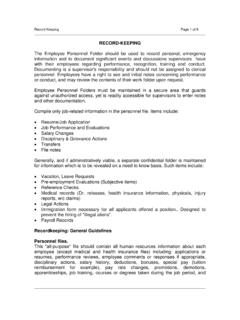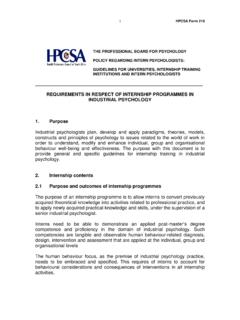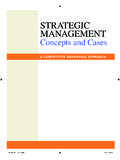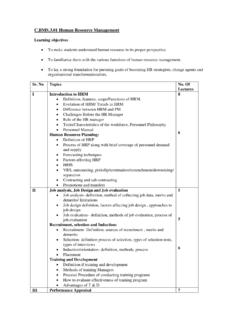Transcription of RETRENCHMENT POLICY 1. Introduction - Catra
1 RETRENCHMENT POLICY and Procedure: Page 1 of 7 RETRENCHMENT POLICY 1. Introduction Changes in the scope of the company activities resulting from technological changes, economic factors, restructuring / re-organisation and operational rationalisation are often accompanied by changing staffing requirements. In certain instances, this may result in employees becoming redundant. The main emphasis is placed on three issues: a) Having a justifiable reason for the RETRENCHMENT . (For example, Introduction of new technology, or a substantial drop in business resulting in financial losses and/or job redundancy). b) Having fair and objective criteria for deciding which employees may be retrenched. (For example, last in first out). c) Following a laid down procedure of consultation with the employees and their representatives for purposes of finding alternatives to RETRENCHMENT and of discussing the terms of a possible RETRENCHMENT in the event that such cannot be avoided.
2 In keeping with the company s human resources philosophy as well as the requirements of the Labour Relations Act 66 of 1995, as amended and the Code of Good Practice on Dismissals Based On Operational Requirements, the company undertakes to consult with any employees on such retrenchments. The aim of the consultation process is two-fold: The company shall seek ways of avoiding or averting the need to terminate the employment of staff and if that proves unavoidable, to find ways of alleviating the hardship which may be caused by the decision to terminate an employment contract. In particular, the parties to the consultation process undertake to consult on appropriate measures- to avoid the dismissals; to minimise the number of dismissals; to change the timing of the dismissals; and to mitigate the adverse effects of the dismissals; and consult on the method for selecting the employees to be dismissed; as well as the severance pay for dismissed employees.
3 RETRENCHMENT POLICY and Procedure: Page 2 of 7 The company has developed guidelines , which will be tabled for discussion and consultation during the consultation process. Whilst these guidelines represent the Company s standard approach to regulating these matters, these guidelines do not in any way bind the Company in formulating its approach to individual or group retrenchments, and are themselves subject to consultation. However, the company will only deviate from these guidelines where compelling reasons exists to do so. Consultations shall be conducted at the level of the business unit affected by the restructuring or RETRENCHMENT , although guidance will be sought from and offered by the Human Resources Department and its advisors. Where circumstances arise which may result in the possible RETRENCHMENT of employees within the Company or business unit, the affected employees will be notified in writing of:- (a) the reasons for the proposed dismissals; (b) the alternatives that the employer considered before proposing the dismissals, and the reasons for rejecting each of those alternatives; (c) the number of employees likely to be affected and the job categories in which they are employed; (d) the proposed method for selecting which employees to dismiss; (e) the time when, or the period during which, the dismissals are likely to take effect; (f) the severance pay proposed; (g) any assistance that the employer proposes to offer to the employees likely to be dismissed.
4 And (h) the possibility of the future re-employment of the employees who are dismissed. The company s approach to various matters, which may arise during the consultation process, are as follows: 2. Alternatives to RETRENCHMENT Where it is appropriate, the following alternatives may be considered along with any other proposals advanced by the employee or any representative bodies: (a) reducing staff numbers through natural attrition; RETRENCHMENT POLICY and Procedure: Page 3 of 7 (b) temporarily suspending recruitment ( while the redeployment of permanent employees is necessary to avoid RETRENCHMENT ); (c) the working of short time at correspondingly reduced salary levels; (d) temporary lay-offs with or without employment benefits or remuneration; (e) on the job training, external courses and/or in-house training courses (where feasible and, subject to reasonable time and cost limits, and where an employee on the redeployment list has the potential to fill a certain vacancy).
5 (f) internal transfers to suitable vacancies, not necessarily at the same job/salary level. (g) voluntary retrenchments and early retirement subject to the retention of key employees based on considerations similar to those identified in section 5 below. (h) Reasonable time off work will be permitted in the notice period to seek alternative employment. (i) The company will provide staff to be retrenched with assistance in preparing CV s. If requested to do so by the staff members, the company will also circulate the CV s to local recruitment agencies. In selecting staff for retention in any RETRENCHMENT , the company may use any of the following principles of, "last in first out" (LIFO) and bumping . There may be instances where the LIFO principle or other criteria may be adapted. For example, the following considerations may apply in respect of selecting staff for retention: (a)Where the operation of LIFO would undermine an affirmative action programme.
6 1 (b)Where employees need to be retained based on criteria, which are fundamental to the successful operation of the business, including operational needs, experience relating to the current job, qualifications, skills and training, length of service, conduct record and work performance. (c) Bumping is the process of moving an employee horizontally or vertically. The following principles will apply in bumping. (i) the process uses as its point of departure the LIFO principle; (ii) that horizontal bumping should take place before vertical bumping is resorted to; 1 In Thekiso v IBM South Afica (Pty) Ltd (2007) 28 ILJ 177 (LC) it was held that s 15(2)(d)(ii) of the EEA does not impose any obligation on an employer contemplating retrenchments to retain black employees in preference to white employees it believes meets its needs.
7 RETRENCHMENT POLICY and Procedure: Page 4 of 7 (iii) that bumping should be implemented in a way that creates the minimum disruption to the workplace; (iv) that geographical limits may be placed on the unit within which bumping is effected; (v) that the size of the unit will depend on the mobility and career paths of the employees concerned; (vi) bumping must be effected with due regard for the retention of necessary skills; (vii) downward bumping should take place where the employee is prepared to accept downgrading in work and status. These and any other exceptions to the operation of the LIFO principle will be treated with caution and be communicated to all affected employees during the consultation process to allow employees to make appropriate representation to the company. 3. Termination benefits On termination of an employee's contract of employment, the employee will be paid:- (a) All annual leave due and payable to the employee; (b) Notice pay (c) Severance pay.
8 The Company will assist the employee in obtaining a tax directive from the Receiver of Revenue on the payment of income tax on any severance pay payable to the employee; (d) Payment of the employer and employee contributions to the company's retirement fund of which the employee is a member. The employee will also be handed: A certificate of service, which will include details for the occupation of the employee at the time of RETRENCHMENT , length of service, salary, and reason for termination. His/her unemployment insurance card and assistance (where requested) in obtaining UIF payment 4. Severance pay The Basic Conditions of Employment Act stipulates that employees are entitled to one week's pay for every completed unbroken year of service. Where employees have prior unbroken service with a business unit in which ABC RETRENCHMENT POLICY and Procedure: Page 5 of 7 COMPANY has acquired (a controlling interest) shareholding, such prior service will be included in the calculation of completed unbroken years of service.
9 5. Selection criteria (a) the reasons for the proposed dismissals; (b) the alternatives that the employer considered before proposing the dismissals, and the reasons for rejecting each of those alternatives; (c) the number of employees likely to be affected and the job categories in which they are employed; (d) the proposed method for selecting which employees to dismiss; (e) the time when, or the period during which, the dismissals are likely to take effect; (f) the severance pay proposed; (g) any assistance that the employer proposes to offer to the employees likely to be dismissed; and (h) the possibility of the future re-employment of the employees who are dismissed The company s approach to various matters, which may arise during the consultation process, are as follows: (a) limits, and where an employee on the redeployment list has the potential to fill a certain vacancy).
10 (b) internal transfers to suitable vacancies, not necessarily at the same job/salary level. (c) voluntary retrenchments and early retirement subject to the retention of key employees based 6. Preferential re-employment The company will implement a preferential re-employment scheme whereby employees who have been retrenched will be given preferential re-employment for a period of twelve months from the date of their RETRENCHMENT , subject to such employees qualifying for employment in the vacant position as well as the selection criteria specified in "Selection Criteria". RETRENCHMENT POLICY and Procedure: Page 6 of 7 NOTICE TO ALL STAFF INVITATION TO COMMENCE WITH CONSULTATIVE PROCESS: OPERATIONAL REQUIREMENTS: DISMISSALS (NO FAULT DISMISSALS). You are hereby informed that management is contemplating a restructuring of the company.













